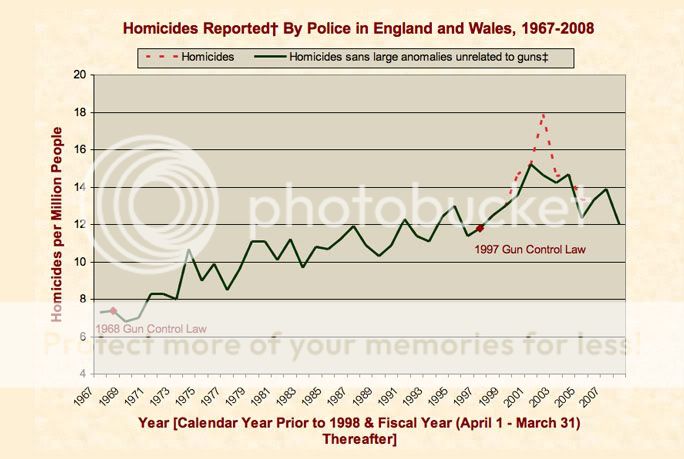Again, while the difference may be statistically significant, that does not mean that the average American has a significant chance of being killed by gunfire in the traditional sense of the word. Gun control advocates mix the two to try to create public anxiety over guns, which is likely the reason that our European friends have such a skewed understanding of American life.Actually, PJ, if you run the chi square on it, you would quickly determine that a .4 versus a seven is highly significant statistically. What that cannot prove, of itself, is whether firearms are the cause of INTENTIONAL deaths. However, even there, recent statistics suggest that you are more than thrice as likely to be intentionally killed in the USA as you are to be killed intentionally in the UK. The question is whether the difference is firearms, culture, or both.
Speaking of stats, here are a few that I found interesting.
Spoiler Alert, click show to read:* Roughly 16,272 murders were committed in the United States during 2008. Of these, about 10,886 or 67% were committed with firearms.[11]
* A 1993 nationwide survey of 4,977 households found that over the previous five years, at least 0.5% of households had members who had used a gun for defense during a situation in which they thought someone "almost certainly would have been killed" if they "had not used a gun for protection." Applied to the U.S. population, this amounts to 162,000 such incidents per year. This figure excludes all "military service, police work, or work as a security guard."[12]
* Based on survey data from the U.S. Department of Justice, roughly 5,340,000 violent crimes were committed in the United States during 2008. These include simple/aggravated assaults, robberies, sexual assaults, rapes, and murders.[13] [14] [15] Of these, about 436,000 or 8% were committed by offenders visibly armed with a gun.[16]
* Based on survey data from a 2000 study published in the Journal of Quantitative Criminology,[17] U.S. civilians use guns to defend themselves and others from crime at least 989,883 times per year.[18]
* A 1993 nationwide survey of 4,977 households found that over the previous five years, at least 3.5% of households had members who had used a gun "for self-protection or for the protection of property at home, work, or elsewhere." Applied to the U.S. population, this amounts to 1,029,615 such incidents per year. This figure excludes all "military service, police work, or work as a security guard."[19]
* A 1994 survey conducted by the U.S. Centers for Disease Control and Prevention found that Americans use guns to frighten away intruders who are breaking into their homes about 498,000 times per year.[20]
* A 1982 survey of male felons in 11 state prisons dispersed across the U.S. found:[21]
• 34% had been "scared off, shot at, wounded, or captured by an armed victim"
• 40% had decided not to commit a crime because they "knew or believed that the victim was carrying a gun"
• 69% personally knew other criminals who had been "scared off, shot at, wounded, or captured by an armed victim"[22]
* In 1976, the Washington, D.C. City Council passed a law generally prohibiting residents from possessing handguns and requiring that all firearms in private homes be (1) kept unloaded and (2) rendered temporally inoperable via disassembly or installation of a trigger lock. The law became operative on Sept. 24, 1976.[33] [34]
* On June 26, 2008, the U.S. Supreme Court, in a 5-4 ruling, struck down this law as unconstitutional.[35]
* During the years in which the D.C. handgun ban and trigger lock law was in effect, the Washington, D.C. murder rate averaged 73% higher than it was at the outset of the law, while the U.S. murder rate averaged 11% lower.[37]* In 1920, Britain passed a law requiring civilians to obtain a certificate from their district police chief in order to purchase or possess any firearm except a shotgun. To obtain this certificate, the applicant had to pay a fee, and the chief of police had to be "satisfied" that the applicant had "good reason for requiring such a certificate" and did not pose a "danger to the public safety or to the peace." The certificate had to specify the types and quantities of firearms and ammunition that the applicant could purchase and keep.[38]
* In 1968, Britain made the 1920 law stricter by requiring civilians to obtain a certificate from their district police chief in order to purchase or possess a shotgun. This law also required that firearm certificates specify the identification numbers ("if known") of all firearms and shotguns owned by the applicant.[39]
* In 1997, Britain passed a law requiring civilians to surrender almost all privately owned handguns to the police. More than 162,000 handguns and 1.5 million pounds of ammunition were "compulsorily surrendered" by February 1998. Using "records of firearms held on firearms certificates," police accounted for all but fewer than eight of all legally owned handguns in England, Scotland, and Wales.[40]

† Homicide data is published according to the years in which the police initially reported the offenses as homicides, which are not always the same years in which the incidents took place.
‡ Large anomalies unrelated to guns:
2000: 58 Chinese people suffocated to death in a shipping container en route to the UK
2002: 172 homicides reported when Dr. Harold Shipman was exposed for killing his patients
2003: 20 cockle pickers drowned resulting in manslaughter charges
2005: 52 people were killed in the July 7th London subway/bus bombings[41]
* Not counting the above-listed anomalies, the British homicide rate has averaged 52% higher since the outset of the 1968 gun control law and 15% higher since the outset of the 1997 handgun ban.[42]
* In 1982, the city of Chicago instituted a ban on handguns. This ban barred civilians from possessing handguns except for those registered with the city government prior to enactment of the law. The law also specified that such handguns had to be re-registered every two years or owners would forfeit their right to possess them. In 1994, the law was amended to require annual re-registration.[43] [44] [45]
* In the wake of Chicago's handgun ban, at least five suburbs surrounding Chicago instituted similar handgun bans. When the Supreme Court overturned the District of Columbia's handgun ban in June 2008, at least four of these suburbs repealed their bans.[46] [47] [48] [49] [50]
* In June 2010, the U.S. Supreme Court ruled (5-4) that Chicago's ban is unconstitutional.[51]
* Since the outset of the Chicago handgun ban, the percentage of Chicago murders committed with handguns has averaged about 40% higher than it was before the law took effect.[55]
* In 2005, 96% of the firearm murder victims in Chicago were killed with handguns.[56]

* On October 1, 1987, Florida's right-to-carry law became effective.[103]
* This law requires that concealed carry licensees be 21 years of age or older, have clean criminal/mental health records, and complete a firearms safety/training course.[104]
* As of July 31, 2010, Florida has issued 1,825,143 permits and has 746,430 active licensees,[105] constituting roughly 5.4% of the state's population that is 21 years of age or older.[106]
* Since the outset of the Florida right-to-carry law, the Florida murder rate has averaged 36% lower than it was before the law took effect, while the U.S. murder rate has averaged 15% lower.[108]
* From the outset of the Florida right-to-carry law through July 31, 2010, Florida has revoked 5,674 or 0.3% of all issued permits. Of these:
• 522 permits were revoked for crimes committed prior to licensure
• 4,955 permits were revoked for crimes committed after licensure, of which 168 involved the usage of a firearm.[109]
[/QUOTE]* In January 1996, Texas's right-to-carry law became effective.[110]
* This law requires that concealed carry licensees be at least 21 years of age (or 18 years of age if a member or veteran of the U.S. armed forces), have clean criminal/mental health records, and complete a handgun proficiency course.[111]
* In 2009, Texas had 402,914 active licensees,[112] constituting roughly 2.4% of the state's population that is 21 years of age or older.[113]
* Since the outset of the Texas right-to-carry law, the Texas murder rate has averaged 30% lower than it was before the law took effect, while the U.S. murder rate has averaged 28% lower.[115]
And finally...
Spoiler Alert, click show to read:* In 2007, there were 613 fatal firearm accidents in the United States, constituting 0.5% of 123,706 fatal accidents that year.[120]

So it appears that the unfortunate case of our young woman double-tapping her friend by mistake would be an exceedingly rare event.













 Reply With Quote
Reply With Quote
Bookmarks